

| Asian American Comparative Collection (AACC) University of Idaho 875 Perimeter Drive, MS 1111 Moscow, Idaho 83844-1111 USA 208-885-7075 |
Priscilla Wegars, Ph.D., Volunteer Curator pwegars@uidaho.edu Renae Campbell, M.A., RPA, Research Assistant rjcampbell@uidaho.edu |
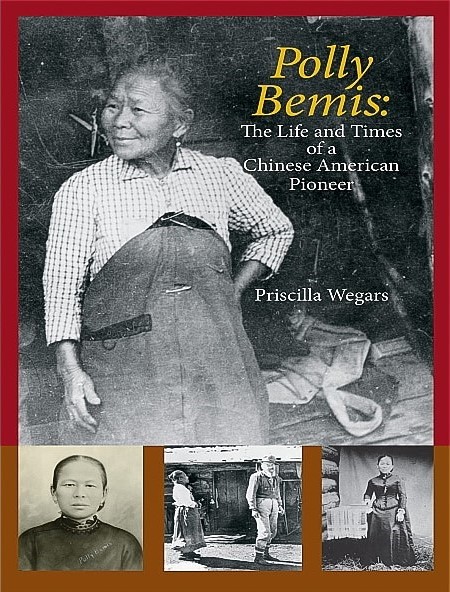 Polly Bemis: The Life and Times of a
Chinese American Pioneer, by Priscilla Wegars, is a
full-length, thoroughly researched biography of one of Idaho's
most famous pioneers. Polly Bemis, the mistakenly named “Lalu
Nathoy” of books and film, was forcibly brought to the United
States, and to Idaho Territory, in 1872 when she was just
eighteen. In 1894 she married a Euroamerican man, Charlie Bemis,
and they moved to a mining claim on the remote Salmon River;
Charlie died in 1922 and Polly died in 1933. Since her death,
Polly Bemis’s life has been greatly romanticized. Supposedly, she
was a prostitute, “Hong King” was her Chinese owner, and Charlie
Bemis “won her in a poker game.” Not one of these statements is
true. Polly’s life was genuinely fascinating, and it is time to
both celebrate the known facts about her and allow the
stereotypical, undocumented legends to die out. 560 pages with
photos, endnotes, index, and bibliography. Pb, $30.00; if you wish
it autographed, please specify recipient. All author's royalties benefit the
AACC.
Polly Bemis: The Life and Times of a
Chinese American Pioneer, by Priscilla Wegars, is a
full-length, thoroughly researched biography of one of Idaho's
most famous pioneers. Polly Bemis, the mistakenly named “Lalu
Nathoy” of books and film, was forcibly brought to the United
States, and to Idaho Territory, in 1872 when she was just
eighteen. In 1894 she married a Euroamerican man, Charlie Bemis,
and they moved to a mining claim on the remote Salmon River;
Charlie died in 1922 and Polly died in 1933. Since her death,
Polly Bemis’s life has been greatly romanticized. Supposedly, she
was a prostitute, “Hong King” was her Chinese owner, and Charlie
Bemis “won her in a poker game.” Not one of these statements is
true. Polly’s life was genuinely fascinating, and it is time to
both celebrate the known facts about her and allow the
stereotypical, undocumented legends to die out. 560 pages with
photos, endnotes, index, and bibliography. Pb, $30.00; if you wish
it autographed, please specify recipient. All author's royalties benefit the
AACC.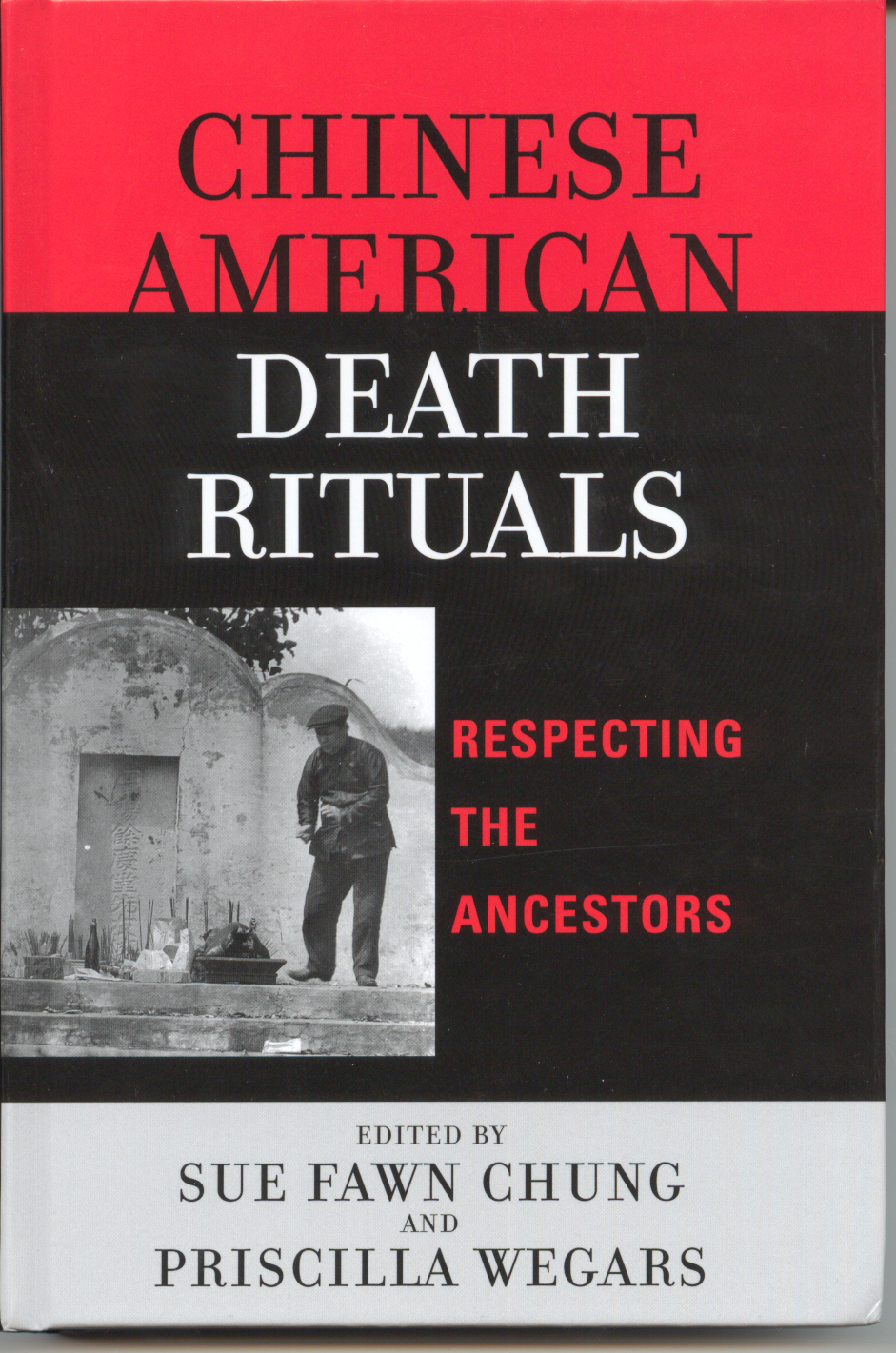 Chinese
American Death Rituals: Respecting the Ancestors, edited
by Sue Fawn Chung and Priscilla Wegars. Why is there sometimes a
chicken in a Chinese funeral procession? Why are Chinese Americans
bringing the remains of their ancestors to the US for reburial?
Why would Chinese Americans place coins in the coffin or in the
mouth, ears, hands, or eyes of their deceased? Why would they
leave food at the grave site and burn paper replicas of cell
phones and other objects there? Chung and Wegars and a selection
of expert contributors answer these questions and more in Chinese American Death Rituals.
For a review in the Asian
Reporter, see http://www.asianreporter.com/reviews/2006/18-06chineseamerican.htm.
Contents: Introduction, by Sue Fawn Chung and Priscilla Wegars;
Chapter 1, "'What We Didn’t Understand': A History of Chinese
Death Ritual in China and California," by Wendy L. Rouse; Chapter
2, "On Dying American: Cantonese Rites for Death and Ghost-Spirits
in an American City," by Paul G. Chace; Chapter 3, "Archaeological
Excavations at Virginiatown’s Chinese Cemeteries," by Wendy L.
Rouse; Chapter 4, "Venerate These Bones: Chinese American Funerary
and Burial Practices as Seen in Carlin, Elko County, Nevada," by
Sue Fawn Chung, Fred P. Frampton, and Timothy W. Murphy; Chapter
5, "Respecting the Dead: Chinese Cemeteries and Burial Practices
in the Interior Pacific Northwest," by Terry Abraham and Priscilla
Wegars; Chapter 6, "Remembering Ancestors in Hawai'i," by Sue Fawn
Chung and Reiko Neizman; Chapter 7, "The Chinese Mortuary
Tradition in San Francisco Chinatown," by Linda Sun Crowder;
Chapter 8, "Old Rituals in New Lands: Bringing the Ancestors to
America," by Roberta S. Greenwood; illustrations, notes,
bibliography, index, 320 pages. Pb, $35.00; if you wish it
autographed, please specify recipient. All authors' royalties benefit the AACC. Published
in 2005 by AltaMira Press.
Chinese
American Death Rituals: Respecting the Ancestors, edited
by Sue Fawn Chung and Priscilla Wegars. Why is there sometimes a
chicken in a Chinese funeral procession? Why are Chinese Americans
bringing the remains of their ancestors to the US for reburial?
Why would Chinese Americans place coins in the coffin or in the
mouth, ears, hands, or eyes of their deceased? Why would they
leave food at the grave site and burn paper replicas of cell
phones and other objects there? Chung and Wegars and a selection
of expert contributors answer these questions and more in Chinese American Death Rituals.
For a review in the Asian
Reporter, see http://www.asianreporter.com/reviews/2006/18-06chineseamerican.htm.
Contents: Introduction, by Sue Fawn Chung and Priscilla Wegars;
Chapter 1, "'What We Didn’t Understand': A History of Chinese
Death Ritual in China and California," by Wendy L. Rouse; Chapter
2, "On Dying American: Cantonese Rites for Death and Ghost-Spirits
in an American City," by Paul G. Chace; Chapter 3, "Archaeological
Excavations at Virginiatown’s Chinese Cemeteries," by Wendy L.
Rouse; Chapter 4, "Venerate These Bones: Chinese American Funerary
and Burial Practices as Seen in Carlin, Elko County, Nevada," by
Sue Fawn Chung, Fred P. Frampton, and Timothy W. Murphy; Chapter
5, "Respecting the Dead: Chinese Cemeteries and Burial Practices
in the Interior Pacific Northwest," by Terry Abraham and Priscilla
Wegars; Chapter 6, "Remembering Ancestors in Hawai'i," by Sue Fawn
Chung and Reiko Neizman; Chapter 7, "The Chinese Mortuary
Tradition in San Francisco Chinatown," by Linda Sun Crowder;
Chapter 8, "Old Rituals in New Lands: Bringing the Ancestors to
America," by Roberta S. Greenwood; illustrations, notes,
bibliography, index, 320 pages. Pb, $35.00; if you wish it
autographed, please specify recipient. All authors' royalties benefit the AACC. Published
in 2005 by AltaMira Press. 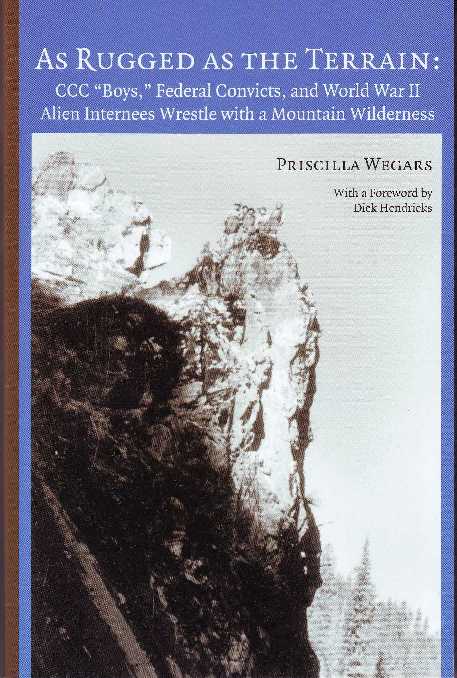 As Rugged as
the Terrain: CCC “Boys,” Federal Convicts, and World War II
Alien Internees Wrestle with a Mountain Wilderness, by
Priscilla Wegars with a Foreword by Dick Hendricks, explores some
intriguing history of Idaho’s wild and scenic Lochsa River. In
1893 this site, at turbulent Canyon Creek, was a footnote in the
saga of the ill-fated Carlin hunting party. Next, in 1933, it held
nearly 200 tent-dwelling Civilian Conservation Corps recruits,
most from New York State. The antics of these “city slickers”
provide colorful insights into CCC camps housing young men far
from home. In 1935 the site became Federal Prison Camp No. 11, a
road-building facility for convicts mostly from the Leavenworth,
Kansas, penitentiary. The authorities stressed rehabilitation,
rather than punishment, but because the camp was not fenced, a few
escapes occurred, some quite thrilling. The prison camp closed in
May 1943, and Japanese detainees at the Kooskia Internment Camp
continued road construction for two more years; see Priscilla
Wegars’ Imprisoned in Paradise: Japanese Internee Road Workers
at the World War II Kooskia Internment Camp (2010). Several
chapters in Rugged continue the Japanese internees’
story, and compare it with the experiences of Italian and German
internees in the vicinity. 393 + xxxviii (431) pages, 110
illustrations, plus notes, appendices, bibliography, index. Pb,
$25.00; if you wish it autographed, please specify
recipient. All author's
royalties benefit the AACC.
As Rugged as
the Terrain: CCC “Boys,” Federal Convicts, and World War II
Alien Internees Wrestle with a Mountain Wilderness, by
Priscilla Wegars with a Foreword by Dick Hendricks, explores some
intriguing history of Idaho’s wild and scenic Lochsa River. In
1893 this site, at turbulent Canyon Creek, was a footnote in the
saga of the ill-fated Carlin hunting party. Next, in 1933, it held
nearly 200 tent-dwelling Civilian Conservation Corps recruits,
most from New York State. The antics of these “city slickers”
provide colorful insights into CCC camps housing young men far
from home. In 1935 the site became Federal Prison Camp No. 11, a
road-building facility for convicts mostly from the Leavenworth,
Kansas, penitentiary. The authorities stressed rehabilitation,
rather than punishment, but because the camp was not fenced, a few
escapes occurred, some quite thrilling. The prison camp closed in
May 1943, and Japanese detainees at the Kooskia Internment Camp
continued road construction for two more years; see Priscilla
Wegars’ Imprisoned in Paradise: Japanese Internee Road Workers
at the World War II Kooskia Internment Camp (2010). Several
chapters in Rugged continue the Japanese internees’
story, and compare it with the experiences of Italian and German
internees in the vicinity. 393 + xxxviii (431) pages, 110
illustrations, plus notes, appendices, bibliography, index. Pb,
$25.00; if you wish it autographed, please specify
recipient. All author's
royalties benefit the AACC.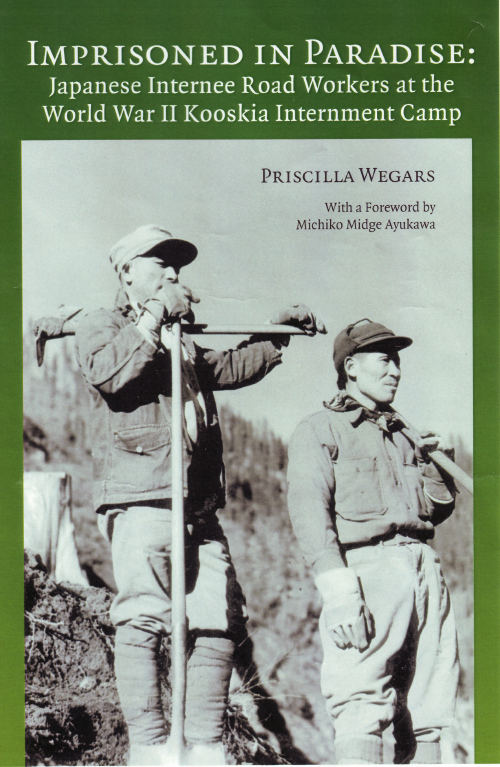
Polly Bemis: A
Chinese American Pioneer, a biography for 4th grade
to adult readers. Hardcover, full color, published by
Backeddy Books in 2003 to honor the sesquicentennial
(150-year-anniversary) of Polly's birth in 1853. Polly
Bemis, the Pacific Northwest’s most famous Chinese woman, lived in
Idaho for over 60 years. After her parents in China sold
her, she was smuggled into this country, purchased by a Chinese
man, and brought to Warren, Idaho. Polly married Charlie
Bemis in 1894 and they settled on the remote Salmon River.
Charlie died in 1922 and Polly died in 1933. Polly
Bemis: A Chinese American Pioneer received the
Idaho Library Association's honorable mention for the best book
about Idaho published in 2003. Sorry, this book is out of print
and is no longer available through the AACC or the publisher;
please check abebooks.com
for used copies.
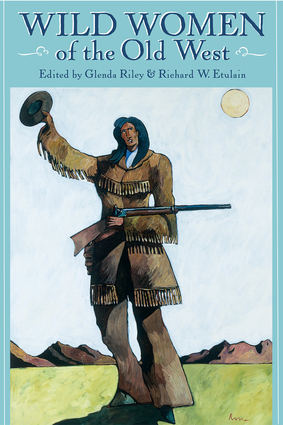 See
also the lengthy chapter "Polly Bemis: Lurid Life or Literary
Legend?" in Wild Women of the Old West,
edited by Glenda Riley and Richard W. Etulain, 45-68, 200-203,
Golden, CO: Fulcrum. Sorry, NOT
available from the AACC.
See
also the lengthy chapter "Polly Bemis: Lurid Life or Literary
Legend?" in Wild Women of the Old West,
edited by Glenda Riley and Richard W. Etulain, 45-68, 200-203,
Golden, CO: Fulcrum. Sorry, NOT
available from the AACC.
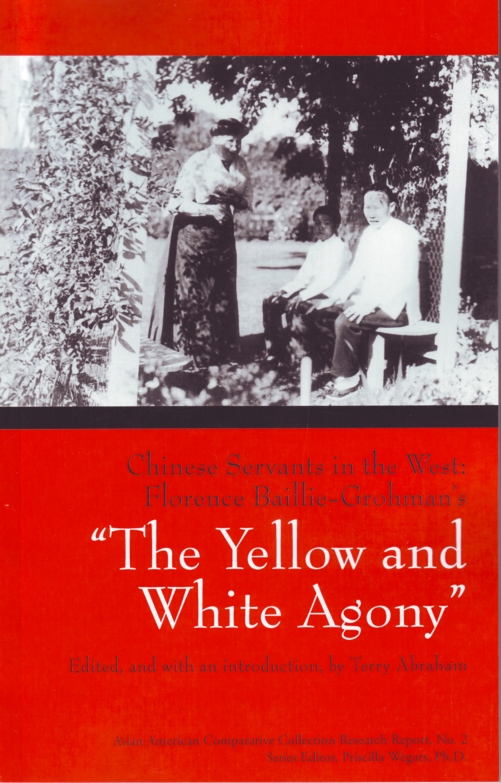 Chinese Servants in the West: Florence
Baillie-Grohman's "The Yellow and White Agony." Edited, and
with an introduction, by Terry Abraham. 65 pages, two photos, notes,
bibliography, index. Pb, $10.00. The nineteenth century West
Coast labor shortage, exacerbated by the pull of the gold fields,
was as acute on the domestic front as on the commercial. Chinese
laborers were recruited to fill the positions of cook, houseboy,
"parlormaid," and "housemaid." Far from being stereotypical, the
Chinese servant was much more complex, both individually and within
the context of a broader social hierarchy. Many of the negative
attributions assigned to Chinese domestics were, in fact, commonly
applied to others, of different races or sexes, who found themselves
in or were forced into the servant role. One account in particular,
that of Florence Nickalls Baillie-Grohman, provides an unparalleled
first-hand story of individual Chinese servants and their
"Missus." Asian American Comparative Collection Research
Report, No. 2, 2007. Series Editor, Priscilla Wegars. Moscow,
ID: University of Idaho Asian American Comparative Collection. 65
pages, two photos, notes, bibliography, index. Pb, $12.00 from
AACC. All proceeds benefit
the AACC.
Chinese Servants in the West: Florence
Baillie-Grohman's "The Yellow and White Agony." Edited, and
with an introduction, by Terry Abraham. 65 pages, two photos, notes,
bibliography, index. Pb, $10.00. The nineteenth century West
Coast labor shortage, exacerbated by the pull of the gold fields,
was as acute on the domestic front as on the commercial. Chinese
laborers were recruited to fill the positions of cook, houseboy,
"parlormaid," and "housemaid." Far from being stereotypical, the
Chinese servant was much more complex, both individually and within
the context of a broader social hierarchy. Many of the negative
attributions assigned to Chinese domestics were, in fact, commonly
applied to others, of different races or sexes, who found themselves
in or were forced into the servant role. One account in particular,
that of Florence Nickalls Baillie-Grohman, provides an unparalleled
first-hand story of individual Chinese servants and their
"Missus." Asian American Comparative Collection Research
Report, No. 2, 2007. Series Editor, Priscilla Wegars. Moscow,
ID: University of Idaho Asian American Comparative Collection. 65
pages, two photos, notes, bibliography, index. Pb, $12.00 from
AACC. All proceeds benefit
the AACC.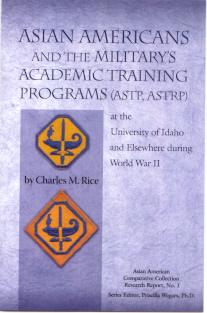 Asian
Americans and the Military's Academic Training Programs (ASTP,
ASTRP) at the University of Idaho and Elsewhere during World War
II, by Charles M. Rice. The UI ASTP/ASTRP
participants included six Japanese Americans, several Chinese
Americans, and one Filipino American, whose hometowns were Los
Angeles, Manzanar, Sacramento, San Diego, San Francisco, and San
Mateo, CA; Boston, MA; Vale, OR; and Garland, Provo, and Topaz, UT.
Manzanar and Topaz were, of course, both War Relocation Authority
concentration camps. Brief sections discuss Japanese Americans and
World War II, the Army Specialized Training Program (ASTP), the Army
Specialized Training Reserve Program (ASTRP), Asian Americans in the
ASTP and ASTRP, Subjects Studied in ASTP and ASTRP, Language
Instruction, Area Studies, Experiences of Racial Minorities in
ASTP/ASTRP, Racism and Discrimination, Japanese Americans Achieve
Redress, and Noteworthy Asian American Participants in ASTP and
ASTRP. Asian American Comparative Collection Research Report, No. 1.
2005. Series Editor, Priscilla Wegars. Moscow, ID: University of
Idaho Asian American Comparative Collection. Booklet, 13 pages, 2
photos (1 color), notes, bibliography. Pb, $6.00. All proceeds benefit the AACC.
Asian
Americans and the Military's Academic Training Programs (ASTP,
ASTRP) at the University of Idaho and Elsewhere during World War
II, by Charles M. Rice. The UI ASTP/ASTRP
participants included six Japanese Americans, several Chinese
Americans, and one Filipino American, whose hometowns were Los
Angeles, Manzanar, Sacramento, San Diego, San Francisco, and San
Mateo, CA; Boston, MA; Vale, OR; and Garland, Provo, and Topaz, UT.
Manzanar and Topaz were, of course, both War Relocation Authority
concentration camps. Brief sections discuss Japanese Americans and
World War II, the Army Specialized Training Program (ASTP), the Army
Specialized Training Reserve Program (ASTRP), Asian Americans in the
ASTP and ASTRP, Subjects Studied in ASTP and ASTRP, Language
Instruction, Area Studies, Experiences of Racial Minorities in
ASTP/ASTRP, Racism and Discrimination, Japanese Americans Achieve
Redress, and Noteworthy Asian American Participants in ASTP and
ASTRP. Asian American Comparative Collection Research Report, No. 1.
2005. Series Editor, Priscilla Wegars. Moscow, ID: University of
Idaho Asian American Comparative Collection. Booklet, 13 pages, 2
photos (1 color), notes, bibliography. Pb, $6.00. All proceeds benefit the AACC.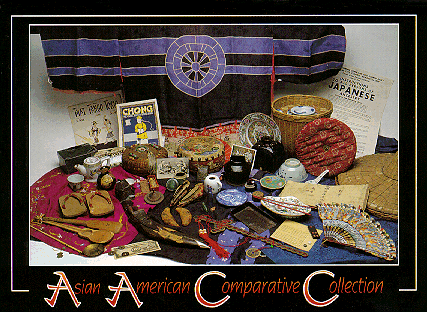 AACC Color Postcard.
Features artifacts representing a variety of Asian cultures. Three
for $1.00. All proceeds benefit
the AACC.
AACC Color Postcard.
Features artifacts representing a variety of Asian cultures. Three
for $1.00. All proceeds benefit
the AACC.
Chinese at the
Confluence: Lewiston's Beuk Aie Temple, by
Priscilla Wegars. Lewiston, ID: Confluence Press in
association with Lewis-Clark Center for Arts & History, 2000;
xii + 41 pages; map, historic and artifact photographs (most full
color), references consulted. Brief sections on the Chinese
in the West, the Chinese in Lewiston, Chinese religion, Lewiston's
Beuk Aie Temple, the Hip Sing Tong, Chinese women, daily life,
occupations, and Chinese mining. Paperbound; $6.00. All proceeds benefit the AACC.
Chinese Artifact Illustrations, Terminology, and Selected Bibliography. Compiled by Priscilla Wegars for the Chinese and Japanese Artifacts Workshop, Society for Historical Archaeology, Salt Lake City, UT, January 1999. Revised July 2012. 13 pages. Photocopy; $5.00. All proceeds benefit the AACC.
Japanese Artifact Illustrations, Terminology, and Selected Bibliography. Compiled by Priscilla Wegars for the Chinese and Japanese Artifacts Workshop, Society for Historical Archaeology, Salt Lake City, UT, January 1999. Revised July 2012. 9 pages. Photocopy; $4.00. All proceeds benefit the AACC.
Guardians and Ghostcatchers: Preparing
for Eternity in Ancient China, an Exhibition of Chinese Tomb
Sculpture from the Collection of Dr. and Mrs. Robert B.
Pamplin, Jr., by Alison T. Stenger. Lewiston,
ID: Lewis-Clark Center for Arts & History, 1998; i + 16
pages; text, chronology, artifact illustrations (full
color). Paperbound; $5.00 prepaid. All proceeds benefit the AACC.
Free with any other order!
The Ah Hee Diggings: Final Report of
Archaeological Investigations at OR-GR-16, the Granite, Oregon
"Chinese Walls" Site, 1992 through 1994, by Priscilla
Wegars, with an Appendix on faunal analysis by Deborah L. Olson.
University of Idaho Anthropological Reports, No. 97, Alfred W.
Bowers Laboratory of Anthropology, University of Idaho, 1995; xvii
+ 250 pages; tables, maps, illustrations, artifact catalogue,
bibliography. Paperbound; price reduced, $19.00. All proceeds benefit the AACC.
Uncovering a Chinese Legacy:
Historical Archaeology at Centerville, Idaho, Once the
'Handsomest Town in the Basin,' by Priscilla Wegars.
Idaho Cultural Resources Series, No. 5, Bureau of Land Management,
Boise, 2001; xvii + 211 pages; photographs, maps, artifact
illustrations, bibliography. Paperbound; available from the BLM
Public Room, 208-373-3889, for $5.00; postage may be extra. Sorry,
NOT available from the
AACC.
Archaeology and History of the
Chinese in Southern New Zealand during the Nineteenth Century:
A Study of Acculturation, Adaptation, and Change, by
Neville A. Ritchie.
Doctoral thesis, University of Otago, Dunedin, New Zealand, 1986;
xx + 711 pp.; numerous illustrations and tables; unbound. $90.00.
All proceeds benefit the AACC.
A Comparative Study of
Mid-Nineteenth Century Chinese Blue-and-White Export Ceramics
from the Frolic Shipwreck, Mendocino County,
California, by Patricia Hagen Jones.
Master's thesis, San Jose State University, 1992; vii + 182 pages;
numerous illustrations and tables. $25.00. All proceeds benefit the AACC.